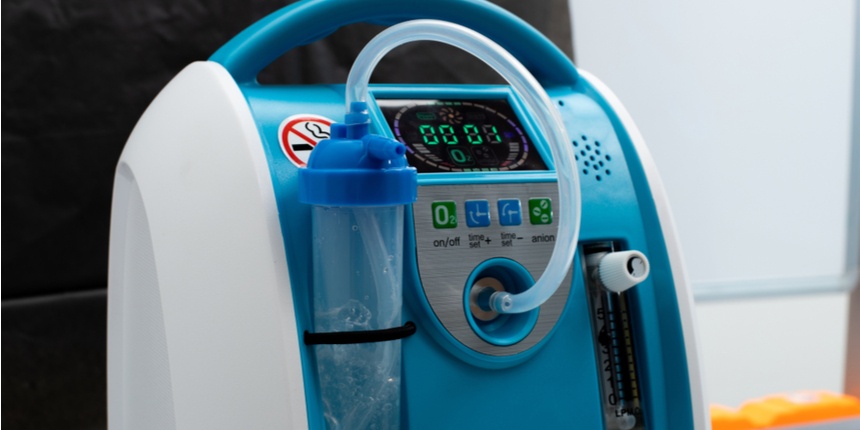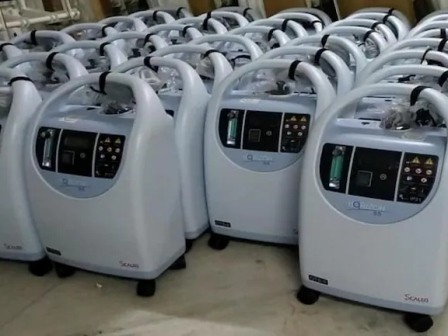How does an Oxygen Concentrator work?
The way an oxygen concentrator works is simple, an Oxygen Concentrator uses the ambient air, which is normally 80% nitrogen and only 20% Oxygen. The oxygen concentrator separates the two components by using zeolite granules to selectively absorb nitrogen from the compressed air.
The compressor raises the air pressure to about 20-lbs per square inch (P.S.I).
The compressed air is introduced into one of the canisters containing zeolite granules where nitrogen is selectively absorbed leaving the residual oxygen available for patient use.
After about 20 seconds the supply of compressed air is automatically diverted to the second canister where the process is repeated enabling the output of oxygen to continue without interruption. While the pressure in the second canister is at 20 P.S.I. the pressure in the first canister is reduced to zero.
This allows nitrogen to be released from the zeolite and returned to the atmosphere. The zeolite is then regenerated and ready for the next cycle. By alternating the pressure in the two canisters so that the first one and then the other are at 20 P.S.I., a constant supply of oxygen is produced while the zeolite is continually being regenerated.
Individual units have an output of up to five liters per minute with an oxygen concentration of up to 95%.

Zeolite used for oxygen concentrator
What is Zeolite?
The word ‘zeolite’ is Greek in origin and means ‘boiling stones’ as natural zeolites visibly lose water when heated.
Zeolite is an inorganic porous material having a highly regular structure of pores and chambers that allows some molecules to pass through and causes others to be either excluded or broken down.
It is in many ways, the inorganic equivalent of organic enzymes, many of which also have specifically sized chambers that trap chemicals within our bodies, holding them where they either break down or react with specific chemicals. Zeolite has many uses.
Parts of Oxygen Concentrator
- Is your Oxygen Concentrator rattling around?
- You may need some quality replacement Motor Vibration mounts.
- Do you turn on the power switch, and nothing happens?
- You may need a new capacitor.
- Does your “Low Oxygen” light taunt you?
- You may need a rebuilt compressor or a fresh set of sieve beds.
No matter what the problem is with your Oxygen Concentrator, check the parts and get a replacement.
New and aftermarket components come with any applicable warranty offered by the manufacturer.
All reconditioned parts and services are repaired by factory-trained technicians. Each component is also quality tested to make sure that without a doubt it will work at or above manufacturer specifications.
Oxygen concentrator filters
The cabinet filters, otherwise known as the intake filter, are made so that you don’t have to replace them very often. The filter that came with your oxygen concentrator, depending on how often you use it, will last you anywhere from 6 to 12 months.
You will, however, need to keep it clean so that the machine will continue working properly. In most oxygen concentrators, this filter is easy to remove from the machine and easy to clean.
It’s important to keep this oxygen concentrator filter clean at all times not only to protect the machine but to prevent things like hair, dust, and dirt debris from entering the machine to be breathed in.
If the filter begins to tear even slightly, it’s time for a new one. Any tears or holes in the filter mean it’s no longer doing its job properly because more particles are able to enter the machine, this bad news for both you and the oxygen concentrator.
If the filter feels thinner and bends more easily than before, it’s too weak to hold back the particles in the air and needs to be replaced. If you use constant oxygen, you may need to replace the filter as often as every 6 months. If you only use it for a few hours a day, you might not need to do it for 12 months or more.
Zeolite Granules for oxygen concentrator
Zeolite is a natural volcanic mineral found in deposits throughout the western half of the United States.
Zeolite is one of the rare minerals that possess a natural negative charge. The combination of the honeycomb structure and net negative charge allows Zeolite to both absorb liquids and adsorb elements based on the strength of the chemical bond.
The magnetic attraction an element has to Zeolite is called the CEC value or ability to ion-exchange while the honeycomb structure utilizes a molecular sieve to filter compounds.
Oxygen therapy at home
Long-term oxygen therapy is one of several methods that increase the duration of survival in chronic obstructive pulmonary disease, with oxygen concentrators being the most appropriate and economical option for this treatment.
Studies carried out so far show that patients misuse a significant amount of oxygen concentrators, technical services are inadequate, devices are not regularly serviced requiring regular maintenance and monitoring, and some devices do not produce the expected oxygen purity in long-term use.
These oxygen concentrator problems are the most important factors causing delays in the treatment process because patients cannot receive oxygen at sufficient purity levels during the scheduled period.
Oxygen machine for home
Therefore, it has become a need for oxygen concentrators to be reorganized as devices that meet medical requirements and minimize patient and device related problems in parallel with developments in the field of medical electronics.
In this study, a low-cost oxygen concentrator that is designed for patients receiving respiratory treatment at home and the practical application of this device is done by oneself, has no method of data transfer to your personal physician.
The most important feature of the designed oxygen concentrator is the ability to detect the failure cases occurring on its own and then forward them to the related technical service and hospital authority through the failure transfer system without relying on the patient’s statement.
This ensures the prevention of delays during the treatment period caused by functional problems of the device.
Keywords: Oxygen concentrator; microcontroller-based system design; GPRS-based fault transfer system; chronic obstructive pulmonary disease; long-term oxygen therapy.
Home oxygen concentrators vary in price and generally cost between $ 600 and $ 2000 depending on batteries and other accessories. Customers can choose to purchase a used home oxygen concentrator, with prices ranging from $ 400 to $ 1,500 depending on hours, warranty, and condition of the unit.
The price of a portable oxygen concentrator on amazon is from 600 to 1200 dollars, on websites such as Alibaba they are from 300 dollars.

Medical Oxygen Concentrator
A medical oxygen concentrator stationary or portable, all oxygen concentrators typically function similarly.

Oxygen Concentrator Price
Is an expensive oxygen concentrator always the right choice for a patient’s stationary or mobile use?
